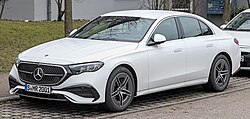Top Qs
Timeline
Chat
Perspective
E-segment
Car size classification in Europe From Wikipedia, the free encyclopedia
Remove ads
The E-segment is the 5th category of the European segments for passenger cars, synonymous with the term executive car.[1][2][3]
2024 best-selling E-segment cars
Mercedes-Benz E-Class
6th generation (2023-present)
6th generation (2023-present)
BMW 5 Series
8th generation (2024-present)
8th generation (2024-present)
Audi A6
5th generation (2018–present)
5th generation (2018–present)
Volvo S90
1st generation (2016-present)
1st generation (2016-present)
E-Segment is a niche in Europe (2-3% penetration in 2010s). In 2017, 2018, 2019 and 2020, E-segment sales accounted for 2.7%, 2.7%, 2.3% and 2.1% market share in Europe, respectively.[4][5][6][7]
Remove ads
Characteristics
Most E-segment cars are sedans/saloons, however several models are also produced in other body styles such as wagons/estates. As of 2021, E-segment cars typically have a length of about 4.8 to 5 m (15.7 to 16.4 ft).
European vs. American classification
The terms E-segment or executive car do not have a one-to-one equivalent in the American car classification. However, if a modern E-segment sedan by a European brand is sold in the U.S., it falls into the category of both mid-size and full-size sedan, usually a mid-size luxury sedan.
The American mid-size sedan classification[note 1] spans both the D-segment and the E-segment. With size brackets of European car segments increasing, the Toyota Camry fell from the E-segment[8] into the D-segment while remaining a mid-size car.
Remove ads
Current models
In 2020, the highest selling E-segment cars in Europe were the Mercedes-Benz E-class, BMW 5 Series, Audi A6, Volvo V90/S90 and Porsche Taycan.[9]
50.000 - 100.000 sales (Best-Selling)
- Mercedes-Benz E-Class
6th generation (2024–present) - BMW 5 Series
8th generation (2024–present) - Audi A6
5th generation (2018–present)
10.000 - 50.000 sales
- Volvo S90
1st generation (2016-present) - Porsche Taycan
1st generation (2019-present)
Fewer than 10.000 sales
- Audi A7
2nd generation (2018-present) - Tesla Model S
1st generation (2012-present) - Mercedes-Benz CLS-Class
3rd generation (2018-2023) - Lexus ES
7th generation (2018-present) - Jaguar XF
2nd generation (2015-2024) - BMW 6 Series Gran Turismo
4th generation (2017-2023) - Maserati Ghibli
3rd generation (2013-2023) - Audi e-tron GT
1st generation (2020–present)
Moved to F-segment
- Porsche Panamera
3rd generation (2024-present) - BMW 8 Series Gran Coupé
2nd generation (2018-present)
Sales figures in Europe
Summarize
Perspective
Notes:
1. The table includes not only E-segment cars, but also a car fitting the F-segment in terms of size (the 2011 Chrysler 300).
2. Our source of information initial include BMW 8 Series in E-segment, but latter moved to F-segment.
Remove ads
Market share in Europe
2019 - Sales of large cars in Europe were down 13% in 2019 to 362,300 units, a new record low annual volume for this class, which now accounts for 2.3% of the total European car market, down from 2.7% in 2018. [18]
2020 - The large cars segment in Europe is down 32% in 2020, to just over 246,000 deliveries. This means the segment loses ground on the overall market again and now accounts for just 2.1% of the total European car market, down from 2.3% in 2019. With the exception of a newcomer, the entire top-8, which accounts for nearly 91% of the segment's sales, drops by 29% or more and thus falls behind the overall market. Only one single model in the class manages to keep its decline limited to single digits. [19]
Remove ads
See also
Notes
- Also, the American full-size sedan classification does not have any equivalent in the European classification with the exception of full-size luxury cars which belong to the F-segment. As European segments denote both size and equipment level, American full-size cars that are not luxury cars simply do not belong to any of the European segments. Considering length only, they would always fall into the F-segment or even exceed its dimensions - with a possible exception of the Toyota Avalon and Nissan Maxima which may or may not be short enough to be considered E-segment (this is as of 2021).
Remove ads
References
Wikiwand - on
Seamless Wikipedia browsing. On steroids.
Remove ads

















